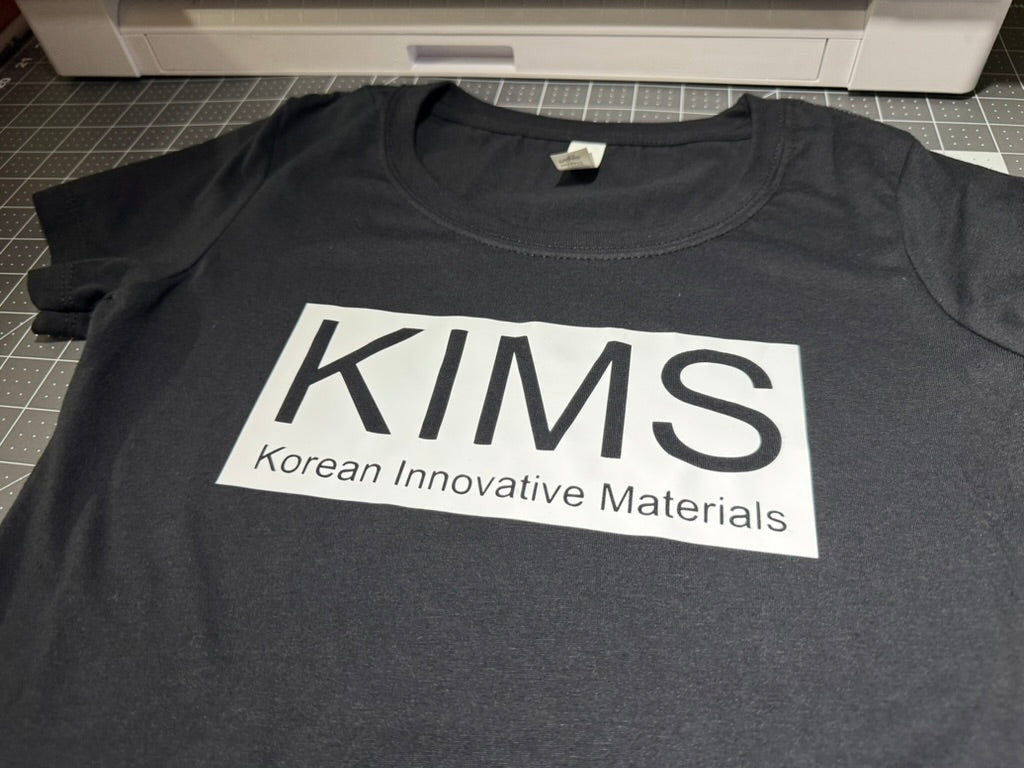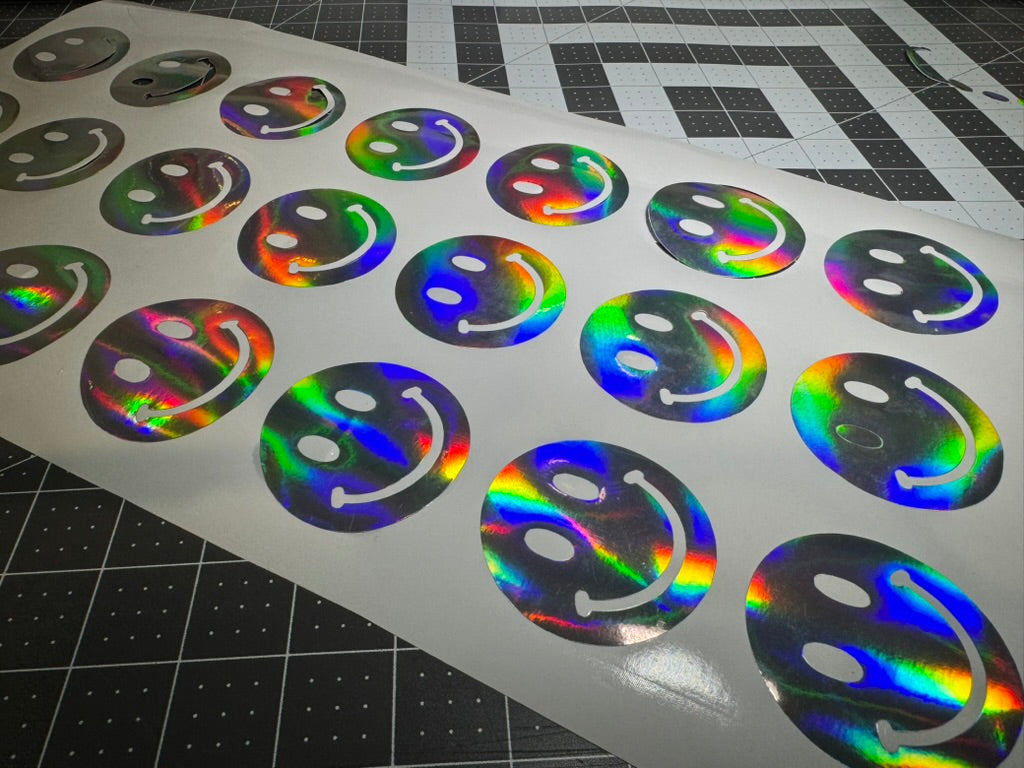Heat Transfer Vinyl, often shortened to HTV, is a specialized material used in custom apparel and fabric decoration. It transfers designs onto fabric using heat and pressure.
Many crafters discover HTV when working on t-shirts, tote bags, or other textile projects. It pairs well with cutting machines like Cricut or Silhouette and is applied using a heat press or household iron.
This guide explains what HTV is, how it works, and the essential tools and techniques for using it successfully. Whether you're making personalized gifts or starting a small business, understanding HTV basics will help you create professional-looking results.
What Is HTV Vinyl And What Does HTV Stand For
Heat Transfer Vinyl (HTV) is a specialized material with a heat-activated adhesive that bonds to fabrics when heat and pressure are applied. HTV stands for Heat Transfer Vinyl. Unlike regular adhesive vinyl, which sticks to surfaces with pressure-sensitive glue, HTV requires heat to adhere to fabrics.
HTV consists of two main layers: a colored vinyl film and a clear carrier sheet. The carrier sheet holds the design in place during cutting and application, while the colored layer contains the heat-activated adhesive that will bond to your fabric.
Most HTV products are made from polyurethane (PU), which gives them flexibility and durability after application. This material feels soft against the skin and moves with the fabric, making it comfortable to wear on clothing items.
When people refer to "iron-on vinyl" or "heat transfer film," they're talking about the same product as HTV. These terms are interchangeable in the crafting community.
Why Choose Heat Transfer Vinyl Over Other Methods
Heat Transfer Vinyl offers distinct advantages for fabric decoration compared to methods like screen printing or sublimation. The heat-activated adhesive creates a strong bond with fabric fibers that remains flexible and durable through repeated washing and wear.
Versatility: HTV works on a wide range of fabrics including cotton, polyester, blends, and even some non-fabric surfaces like wood and leather.
Durability: When applied correctly, HTV designs can last for years without peeling or fading, even with regular washing.
Ease of Use: Creating with HTV requires minimal equipment to start—just a vinyl cutter, heat source, and the vinyl itself.
|
Method |
Cost |
Durability |
Ease of Use |
Suitable Applications |
|---|---|---|---|---|
|
HTV |
Low-Med |
High |
Easy |
T-shirts, bags, hats, more |
|
Sublimation |
Med-High |
High |
Moderate |
Polyester, hard surfaces |
|
Screen Print |
Med-High |
High |
Moderate |
Bulk apparel, flat surfaces |
HTV is particularly valuable for small-batch production and custom designs. Unlike screen printing, which becomes cost-effective only with larger quantities, HTV allows for economical one-off projects and personalized items.
The process is also cleaner than other methods, requiring no messy inks or chemicals. This makes it ideal for home crafters and small businesses without dedicated production spaces.
Types Of HTV And Special Finishes
Standard PU (Polyurethane) HTV is the most common variety, featuring a thin, soft, and flexible material ideal for everyday apparel. It has a smooth finish that blends well with fabric and comes in virtually every color imaginable.
Glitter HTV contains embedded sparkly particles that add visual texture and shine to designs. It's slightly thicker than standard HTV and perfect for creating eye-catching accents on shirts, accessories, or decorative items.
Reflective HTV contains microscopic glass beads that reflect light when illuminated. This material is commonly used for safety gear, athletic wear, or designs that need to be visible in low-light conditions.
Metallic HTV provides a shiny, mirror-like surface that mimics the appearance of metal foil. It's available in gold, silver, copper, and various other metallic colors, adding a premium look to designs.
3D Puff HTV expands when heated, creating a raised, dimensional effect. The vinyl literally puffs up during the heat application process, resulting in designs with physical texture that stands out from the fabric.
Printable HTV allows for full-color designs to be printed directly onto white HTV using an inkjet printer with compatible inks. After printing, the design can be cut and applied like regular HTV, enabling complex, multi-colored images.
Other specialty options include:
-
Glow-in-the-dark HTV that absorbs light and emits a glow in dark environments
-
Holographic HTV with rainbow-like color shifts and patterns
-
Flock HTV with a soft, velvet-like texture for a luxurious feel
Each type serves different design purposes and can be selected based on the specific project requirements and desired aesthetic.
Essential Tools For Printing HTV
A vinyl cutter or plotter is the primary tool for working with HTV. This device precisely cuts your design into the vinyl material without cutting through the carrier sheet. Popular options include Cricut and Silhouette machines for beginners, or commercial-grade cutters from brands like Roland or Graphtec for professional use.
A heat press provides consistent temperature, pressure, and timing for applying HTV to fabrics. While household irons can work for occasional projects, a dedicated heat press ensures more reliable results. Heat presses come in various styles:
-
Clamshell presses that open and close like a book
-
Swing-away presses where the upper platen moves to the side
-
Draw presses where the lower platen pulls out like a drawer
Weeding tools help remove unwanted vinyl from around your cut design. These include fine-point tweezers, hook tools, and specialized weeding picks designed to lift tiny pieces of vinyl without damaging the design.
Heat-resistant tape secures designs in place during the heat application process. This specialized tape withstands high temperatures without melting or leaving residue, making it ideal for multi-layer designs or projects requiring precise alignment.
For beginners, a basic setup might include:
-
An entry-level cutting machine like Cricut Explore or Silhouette Cameo
-
A small heat press or high-quality iron with temperature control
-
Basic weeding tools
-
Heat-resistant tape
As your skills advance, investing in higher-quality tools can improve efficiency and results, especially for detailed designs or larger production volumes.
How To Use Vinyl Heat Transfer On Fabric
1. Create Or Select Your Design
Begin by creating or choosing a design that works well with HTV. Vector-based graphics typically produce the best results. If you're using a Cricut or Silhouette machine, their respective software programs make it easy to create or import designs. For beginners, simple text or basic shapes offer a great starting point before tackling more complex designs.
2. Mirror And Cut The HTV
Always mirror your design before cutting—this flips the image horizontally so it appears correctly when transferred to fabric. Place your HTV on the cutting mat with the shiny carrier sheet facing down. The dull-colored side should face up. Adjust your cutting settings based on the specific type of HTV you're using. Different vinyl thicknesses and compositions require different blade depths and cutting pressures.
3. Weed The Excess Vinyl
After cutting, remove all the vinyl that isn't part of your design. This process, called weeding, requires patience and attention to detail. Start from one corner and work methodically across the design. Use a weeding tool to carefully lift and pull away excess vinyl, paying special attention to small details and interior spaces of letters like "A" or "O."
4. Heat Press Vinyl Transfer Process
Preheat your fabric for 3-5 seconds to remove moisture and wrinkles. Position your weeded design on the fabric with the carrier sheet facing up. Cover with a protective sheet (Teflon or parchment paper) to prevent the vinyl from sticking to your heat press. Apply heat according to the vinyl manufacturer's specifications:
|
Fabric Type |
Temp (°F) |
Time (sec) |
Pressure |
|---|---|---|---|
|
Cotton |
305 |
10-15 |
Medium |
|
Polyester |
285 |
10-15 |
Medium |
|
Blends |
300 |
10-15 |
Medium |
5. Peel And Final Inspection
Different HTV products require different peeling methods. Some are "hot peel" (remove carrier while still hot), others are "warm peel" or "cold peel" (wait until cooled). Check the instructions for your specific vinyl. After peeling, inspect the design to ensure complete adhesion. If any edges are lifting, replace the protective sheet and apply heat for a few more seconds.
How To Remove And Troubleshoot HTV Issues
1. Heating And Peeling For Removal
To remove unwanted or misapplied HTV, apply heat to the vinyl using a heat press or iron set to medium-high temperature. Heat the area for 10-15 seconds until the adhesive softens. While the vinyl is still warm, gently lift one edge using tweezers or a weeding tool, then slowly peel it away from the fabric. For stubborn areas, apply more heat and continue peeling gradually rather than forcing it.
2. Using Solvents For Stubborn Adhesive
If heat alone doesn't remove all the vinyl or leaves adhesive residue, try using rubbing alcohol (isopropyl alcohol) on a clean cloth. Dab the cloth on the residue and gently rub in a circular motion. Avoid saturating the fabric, especially with synthetic materials that might be damaged by solvents. For natural fabrics, commercial adhesive removers designed for textiles can also be effective.
Common HTV application issues can be prevented with proper technique:
-
Peeling Or Cracking: Usually results from insufficient heat, pressure, or time during application. Ensure your heat press is reaching the correct temperature and apply firm, even pressure for the full recommended duration.
-
Proper Pressure And Temperature: Use a heat press rather than an iron when possible for consistent results. If using an iron, press firmly and move slowly to ensure even heat distribution.
-
Fabric Compatibility: Not all HTV works on all fabrics. Standard HTV performs best on cotton, polyester, and blends. Specialty fabrics like nylon, leather, or water-resistant materials may require specific HTV formulations designed for those surfaces.
When troubleshooting, remember that different brands and types of HTV have different application requirements. Always check the manufacturer's instructions for the specific product you're using.
Frequently Asked Questions About Vinyl And HTV
What fabrics work best with heat transfer vinyl?
Cotton, polyester, and cotton/poly blends provide the best surface for HTV adhesion because they can withstand the necessary heat and create a strong bond with the vinyl adhesive.
Can heat transfer vinyl be applied to wood or other non-fabric surfaces?
Yes, HTV can adhere to smooth wood, canvas, and some plastics when applied with appropriate heat and pressure, though results vary based on the surface texture and heat resistance.
How long does properly applied heat transfer vinyl last on garments?
Properly applied HTV typically lasts through 50+ wash cycles when cared for according to recommendations, including washing garments inside-out and avoiding harsh detergents or bleach.
Is iron-on vinyl material the same as heat transfer vinyl?
Yes, iron-on vinyl and heat transfer vinyl are the same product, with both terms referring to vinyl material that uses heat-activated adhesive to bond to fabrics.
Can different types of HTV be layered in one design?
Most HTV types can be layered to create multi-color designs, though specialty finishes like glitter or metallic work best as top layers, and each layer requires separate cutting, weeding, and heat application.
Making Your Next Project A Success With Premium Materials
Quality heat transfer vinyl makes a noticeable difference in both the application process and the finished product. Premium HTV cuts more precisely, weeds more easily, and adheres more consistently than budget alternatives. This means cleaner lines, less frustration, and designs that last longer through washing and wear.
When selecting HTV for your projects, consider both the specific application requirements and the quality of the material. Higher-quality vinyl typically offers better color retention, more consistent thickness, and superior adhesive formulation. These factors contribute to a more professional-looking result and greater durability over time.
The right vinyl choice also affects workflow efficiency. Premium vinyl is less likely to tear during weeding, reducing wasted materials and time spent correcting mistakes. It also tends to apply more reliably at recommended settings, minimizing the need for repeated pressing or adjustments.
KIMS Direct offers a range of high-performance HTV products engineered for both beginners and professionals. Our vinyl features enhanced cutting precision and easier weeding, allowing you to create more detailed designs with less effort. Our products include standard colors, specialty finishes like 3D Puff and reflective, and materials optimized for different fabric types.
Shop our vinyl rolls and heat transfer products at KIMS Direct.







